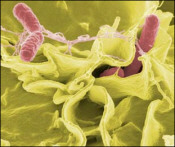



Microbiological Analysis Advice For Meat, Eggs
EU - A new publication, focusing on microbiological analysis, advises meat and egg processors on how to use the technology to prevent contamination and food-borne illnesses such as salmonella. |
|
Salmonella Cells |
The advice couldn't be more timely, as the EU is currently clamping down on all food-borne pathogens, and meat and eggs are still the number one cause of potentially fatal diseases related to food.
According the editor of "Microbiological analysis of red meat, poultry and eggs", G. C. Mead, there were around 0.6 millions cases of food-borne illnesses attributed to red meat and poultry between 1996 and 2000 in England and Wales alone. In this four year period 305 cases led to death.
Microbiological analysis is one of the most effective ways of controlling the safety and quality of foods, Mead said, as it identifies the viruses, bacteria, fungi and parasites that cause disease such as salmonella and E coli.
Each chapter of the book examines various aspects of microbiological analysis such as sampling methods, the use of faecal indicators, current approaches to food testing, the detection of pathogens, and microbial identification techniques.
The book also features sections on current EU food safety legislation.
Earlier this month, the European Commission set targets for member states to meet in reducing the presence of Salmonella in poultry, in a specific crackdown on food-borne pathogens.
Source: foodproductiondaily.com











